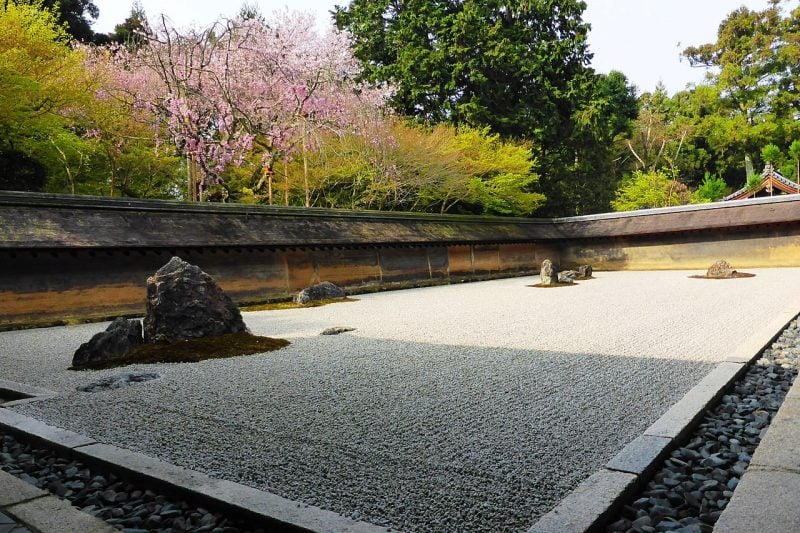Kyoto is truly a garden lover’s paradise, boasting the highest number of exceptional gardens in Japan! With over 1600 temples in the city, picking just ten gardens was quite the challenge. Each garden here showcases every imaginable Japanese garden style—from the serene minimalist karesansui (Zen gardens) to the grand stroll gardens that Shoguns and Emperors once enjoyed. During my visits to these beautiful Kyoto gardens, I discovered unique stories that offered wonderful insights into Japan’s rich cultural heritage.
These gardens are a perfect peaceful retreat from Japan’s fast-paced lifestyle. I’m always amazed by the amazing design of Kyoto’s finest gardens and how they capture nature’s subtle beauty. So, let me take you on a delightful journey through 10 stunning gardens you absolutely must see on your next trip to this historic city!
1. Kyoto Botanical Gardens

The Kyoto Botanical Gardens, Japan’s oldest public botanical garden, opened its doors in 1924. The garden closed briefly in 1945 but reopened to welcome visitors again in 1961. This beautiful space spans 240,000 square meters (about 24 hectares) and houses 120,000 plants from 12,000 different species.
The garden’s appearance changes dramatically with each season. Spring brings 500 cherry trees into full bloom. Visitors can enjoy a more relaxed hanami experience here than at crowded tourist spots. The garden boasts 100 different cherry tree varieties, making it Kyoto’s best location to see diverse cherry blossoms.
Summer fills the garden with color from 180 varieties of hydrangea. The gates open early at 7am during July so visitors can see lotus flowers before they close in the morning heat.
Autumn paints the garden in brilliant reds as maple leaves change color. The scene becomes even more stunning with chrysanthemums in bloom. Winter doesn’t disappoint either – the conservatory protects its tropical plants, orchids, and succulents from the cold.
The garden features several specialized areas:
- Cherry Trees Grove (with 100 different cultivars)
- Hydrangea Garden (2,500 plants of 180 types)
- Japanese Iris Garden
- Bamboo Garden
- Lotus Pond
- European Style Garden
- Rose Garden (featuring 1,400 plants of 320 varieties)
- Bonsai Exhibit
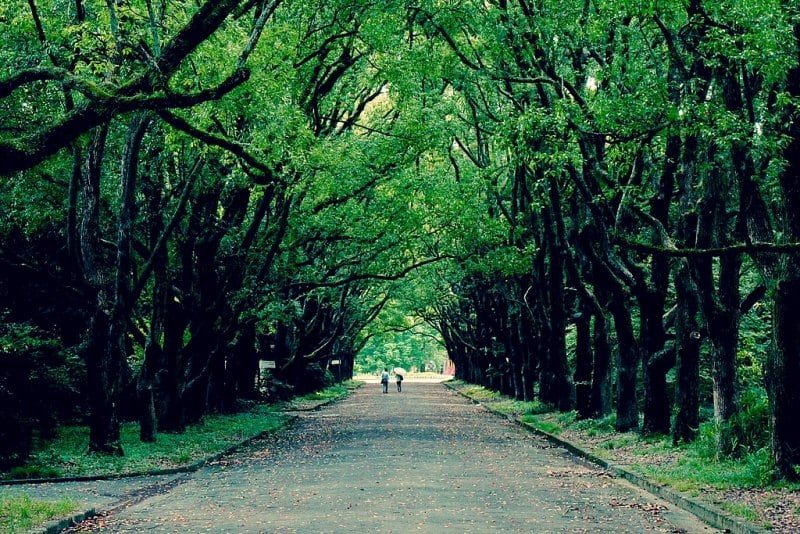
The conservatory stands out as the garden’s crown jewel. This massive glass structure covers nearly 50,000 square feet (4,694 m²), making it one of Japan’s largest. Built in 1992 and updated in 2013, it houses 25,000 specimens from 4,500 species. Visitors can explore different zones including the Jungle Zone, Orchids Room, and Desert and Savanna Plants Room.
The garden offers a quiet escape from Kyoto’s bustling tourist spots. Adult admission costs ¥500, with reduced rates for seniors and high school students. Regular visitors can buy annual passes for ¥2,000.
Getting here is easy. The garden sits a short walk from Kitayama Station on the Kyoto City Subway. Opening hours run from 9am to 5pm daily (last entry at 4pm), while the conservatory welcomes visitors from 10am to 4pm.
This living plant museum, loved by locals but often missed by tourists, reveals new treasures with each visit. The garden’s beautiful design, seasonal displays, and educational value make it a perfect spot to experience Japanese garden artistry at its finest.
2. Byodo-in Temple’s Garden
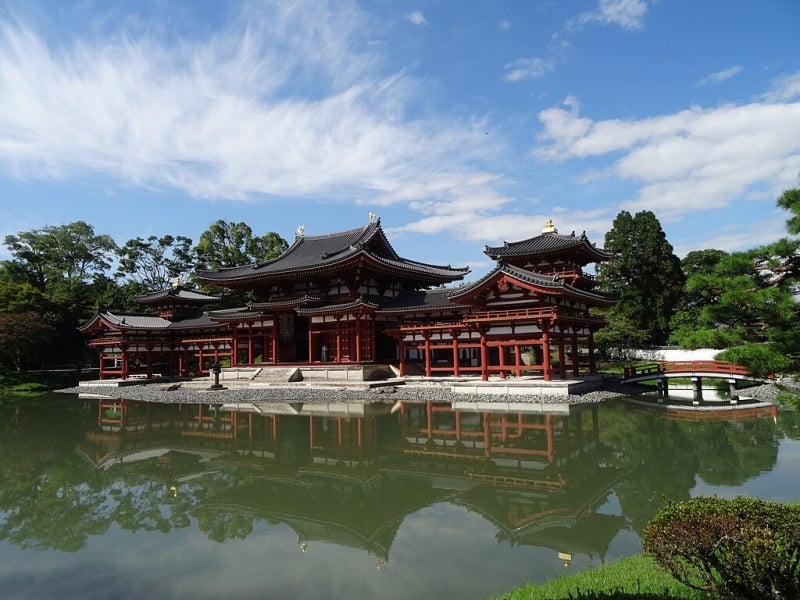
The magnificent Byodo-in Temple’s Garden sits in the city of Uji. This garden stands as the best example of the Jodo Garden style from the Heian period (794–1185). Visitors to this historical treasure in Kyoto prefecture can experience Japan’s rich cultural heritage through its detailed design and deep symbolism.
The breathtaking Phoenix Hall (Hōō-dō) or Amida Hall anchors the garden’s center. Regent Yorimichi Fujiwara built this masterpiece in 1053. The hall remains the only original building from the temple complex after a civil war destroyed other structures in 1336. People started calling it Phoenix Hall in the early 17th century because its front view resembles a bird with spread wings. Two phoenixes on the rooftop complete this image.
Byodo-in stands out among Kyoto’s Japanese gardens because of its spiritual purpose. The garden recreates the Buddhist Pure Land (Jodo) of Amida Buddha on earth. The Phoenix Hall, Aji-ike Pond, Uji River, and distant mountains blend to paint a picture of the perfect realm that Heian period aristocrats dreamed of reaching.
The garden’s eastern orientation holds deep meaning. The hall faces east, suggesting the Buddhist Pure Land lies west across the Aji-ike Pond. Visitors must cross the pond to reach this paradise, creating a spiritual path within the garden’s physical space.
A special lantern stands before the Phoenix Hall. This lantern differs from others with its large fire box and two open sides. Traditional stories say this design helped light up the Amida Buddha statue inside the hall.
The garden changes beautifully with seasons. Cherry blossoms paint the spring landscape before giving way to wisteria in mid-April. The Toka tea room lets visitors sip green tea while taking in this enchanting view.
A crescent-shaped path leads visitors around the Phoenix Hall, showing different angles of this architectural wonder. The pond’s surface mirrors the hall on clear days, creating stunning reflections that photographers love to capture.
Byodo-in Garden earned recognition as both a National Historic Site and a Place of Scenic Beauty. The garden’s status as the oldest surviving Jodo garden from the Heian period makes it essential for anyone interested in authentic Japanese garden design.
The garden follows principles from the Sakuteiki, one of the world’s oldest garden design manuals. Tachibana no Toshitsuna, second son of Fujiwara no Yorimichi who changed the villa into a temple, wrote this thirteenth-century text. Though we don’t know if he used Byodo-in as his model, the garden shows the ideals described in his influential work.
Kyoto’s gardens offer many wonders, but Byodo-in shows how Japanese garden design exceeds pure esthetics. It creates an ideal expression of humanity’s connection with nature.
3. Ryoan-ji’s Rock Garden
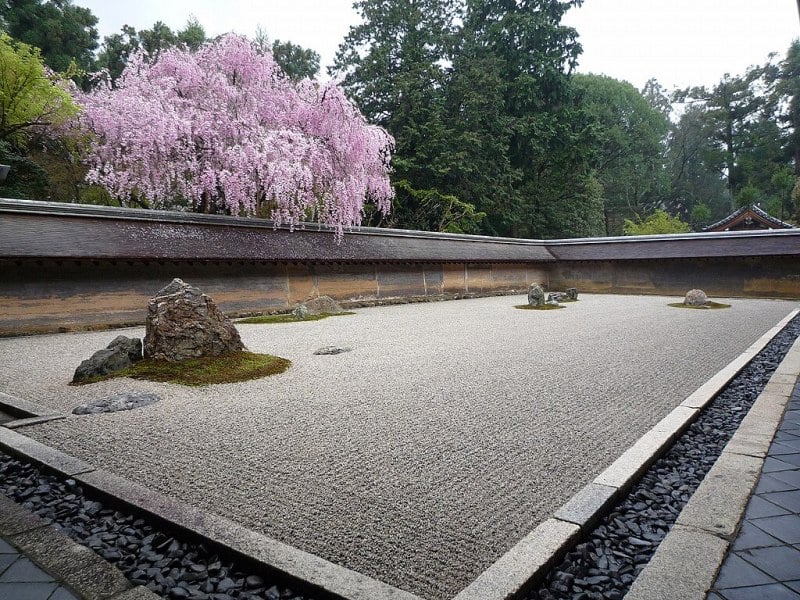
The enigmatic Ryoan-ji Temple’s Rock Garden stands out among the best gardens in Kyoto as evidence of Zen Buddhist philosophy and minimalist beauty. It’s such a lovely spot to reflect and enjoy the serene atmosphere! This UNESCO World Heritage Site in north Kyoto draws visitors with its simple yet mysterious design.
The site started as an aristocrat’s villa in the Heian Period before becoming a Zen temple in 1450. Nobody knows exactly when the garden was created, but scholars think it was designed in the late 15th century. The garden we see today dates back to the Edo period.
Ryoanji’s famous rock garden is the main attraction – a rectangular plot that measures 25 meters by 10 meters (about 248 square meters). Fifteen rocks of different sizes sit arranged in five groups on moss patches. White gravel surrounds these stones, and monks rake it carefully each day. The gravel patterns often represent flowing water, like rivers, waterfalls, or the sea.
The sort of thing I love about this garden is its clever design – you can’t see all fifteen rocks at once from any spot. This setup has deep meaning, showing how we can never see the whole picture at once – just like our limited human view of life.
Visitors view the garden from the Hojo, where the head priest once lived. The building shows off painted sliding doors (fusuma) and small gardens at the back. A clay wall stands behind the rock garden. Time has given it subtle brown and orange tones that work beautifully with the stones.
People have come up with many meanings for the garden over the centuries. Some say it shows islands in an ocean or mountain peaks above clouds. Others think it’s a tiger family crossing a river. Many scholars believe it represents Japanese ideas of wabi (refined austerity) and sabi (subdued taste).
Garden historian Gunter Nitschke has a different take: “The garden at Ryōan-ji does not symbolize anything… I call it an abstract composition of ‘natural’ objects in space, a composition whose function is to incite meditation”.
Research published in Nature shows the garden’s empty space is arranged to match the temple’s architecture. This suggests designers carefully planned the layout to appeal to our unconscious visual preferences.
The grounds stretch beyond the rock garden. There’s a big park with Kyōyōchi (Mirror Pond) from the villa days. You’ll find a small shrine on one of its three islands, connected by a bridge. On top of that, there’s a restaurant that serves Yudofu (boiled tofu), a Kyoto specialty, in tatami rooms with views of a traditional Japanese garden.
Ryoanji is a chance to experience pure Zen esthetics through its simple yet complex design. This masterpiece keeps inspiring deep thoughts in everyone who visits, making it a must-see spot for anyone learning about Kyoto’s magnificent gardens.
4. Katsura Imperial Villa
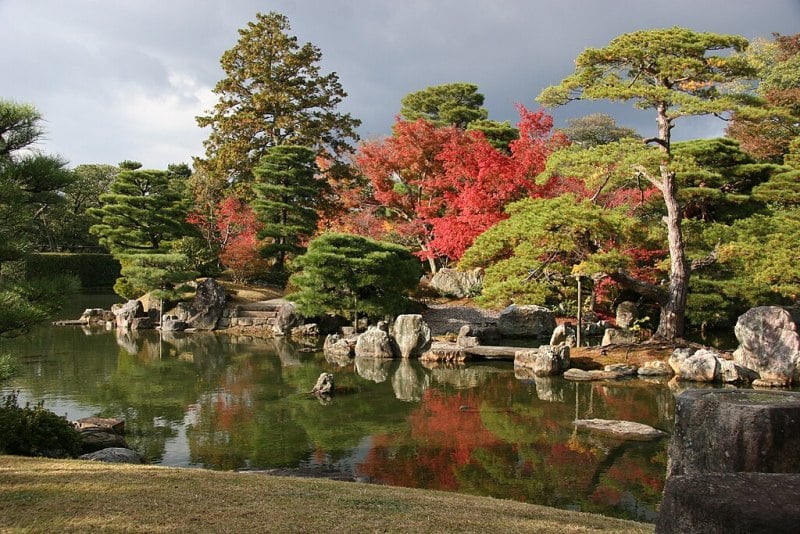
Katsura Imperial Villa stands in Kyoto’s western suburbs as a masterpiece of Japanese architecture and ranks among the best gardens in Kyoto. The first and second generations of the Hachijō-no-miya family, Toshihito Shinno and Toshitada Shinno, built this magnificent estate during the early and mid-seventeenth century. Many consider it the most beautiful Japanese garden ever created.
This stunning property covers about 16 acres (6.5 hectares) and rests along the Katsura River’s banks, which feeds its peaceful ponds and streams. Prince Toshihito, the emperor’s younger brother, received the estate in 1590 and devoted himself to its development until he died in 1629. His son Prince Toshitada later finished the villa we see today by adding two tea pavilions and extensive stonework throughout the garden.
Three connected structures known as ko-shoin, chu-shoin, and shin-shoin—old, middle, and new halls—showcase classic Japanese architectural principles. These buildings create a typical shoin-style arrangement with stepped, intersecting roofs and open interior spaces that blend naturally together. The villa masterfully combines Shoin-zukuri and Sukiya-zukuri architectural styles, showcasing the finest traditional Japanese craftsmanship.
This garden stands out among other gardens of Kyoto because of its clever design. Visitors can enjoy different views as they walk along paths around the central pond in this ‘stroll garden’ layout. The design cleverly uses ‘borrowed scenery’ to incorporate distant mountains, creating an endless vista that extends beyond the garden itself.
Several tea houses dot the grounds, each with its own character and design. Both princes loved the tea ceremony, and built four distinct teahouses to represent the seasons. The Moon Viewing Pavilion draws inspiration from the famous Tale of Genji and creates magical scenes when moonlight dances on the water.
The Imperial Household Agency now manages the villa, which Japan recognizes as an Important Cultural Property. Visitors who want to explore this Japanese garden in Kyoto need advance reservations for guided tours. You can reach the villa from Kyoto Station by taking City Bus No. 33 (20 minutes) or walk about 15 minutes from Katsura Station on the Hankyu Kyoto Line.
The Imperial Villa remains closed to casual visitors, but guided garden tours are available with prior booking. These tours give visitors a chance to see this remarkable example of Japanese garden design that shapes architecture and landscape design across the world.
5. Kyoto Gyoen National Garden
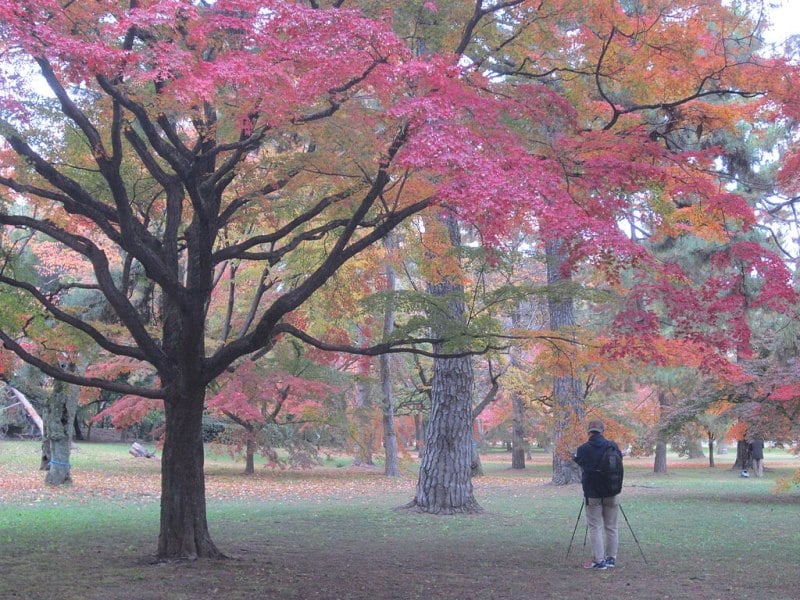
Kyoto Gyoen National Garden stands like a green island in the heart of Kyoto Basin. This beautiful garden measures 700 meters east to west and 1.3 kilometers north to south. It ranks among the most peaceful yet lesser-known Japanese gardens in Kyoto.
The garden’s story begins in the Heian period (794-1185) with the construction of the emperor’s residential palace. The site grew into a neighborhood for court nobles and became Japan’s cultural and political center. The 1868 Meiji Restoration moved the capital to Tokyo, leaving the area neglected.
Emperor Meiji began a mission to revive the site by turning it into the Imperial Palace’s outer garden. Local residents and people from all over Japan donated trees, and new garden paths emerged. The early Taisho era (1912-1926) saw major renovations that shaped the garden we see today.
This best garden in Kyoto boasts incredible natural diversity. You’ll find about 50,000 trees and more than 500 plant species. The garden serves as home to over 100 wild bird species, including northern goshawk and brown hawk-owl. The garden also hosts more than 50 butterfly species and 400 mushroom varieties.
Each season brings a unique charm to the garden. Spring dazzles visitors with over 1,100 cherry trees, featuring weeping cherry trees (itozakura) and Japanese garden cherries. The itozakura at the former Konoe estate creates a spectacular sight with its rose pink flowers blooming on delicate branches.
The garden earned National Garden status after World War II, welcoming everyone with free entry at any time. Several historical sites grace the grounds, including the Kyoto Imperial Palace, Kyoto Sento Imperial Palace, and the Kyoto State Guest House.
The garden provides a peaceful escape from Kyoto’s crowded tourist attractions. You can reach it easily from Marutamachi and Imadegawa subway stations. Unlike other gardens of Kyoto, its level ground makes it easy to explore, even for those who find walking challenging.
My walk through this green sanctuary showed me how 150 years of dedicated care created the largest forest in central Kyoto—evidence of Japan’s commitment to keeping natural beauty alive in the urban landscape.
6. Murin-an Garden
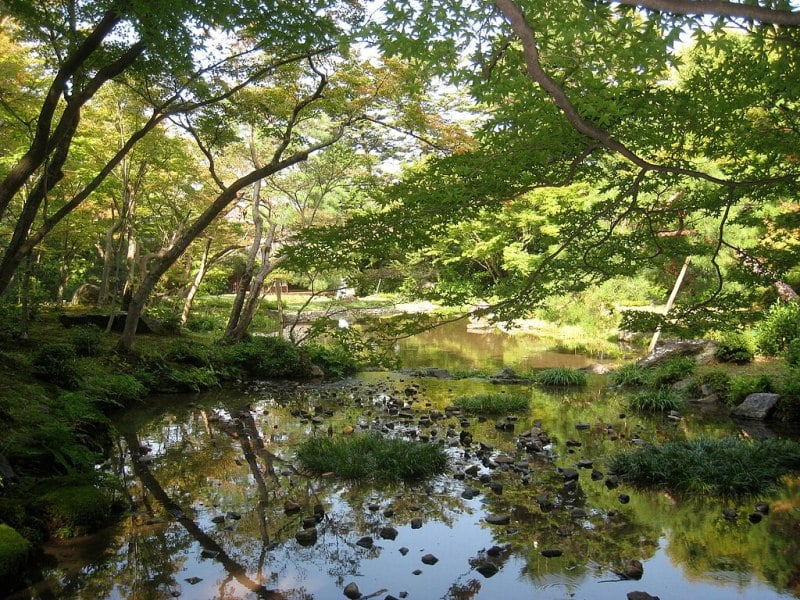
Murin-an Garden, built from 1894 to 1896, shows Japan’s shift toward modern garden design. Yamagata Aritomo, a prominent military general and two-time prime minister of Japan with a keen eye for gardens, commissioned this masterpiece. The garden stands unique as the only villa garden in the Nanzen-ji Temple area that welcomes visitors throughout the year.
The garden’s place among the best gardens in Kyoto comes from its break with tradition. Instead of using ponds as oceans or rocks as islands, the design takes a natural approach that brings movement to life. The clever design makes the Higashiyama Mountains the main focus rather than just background scenery.
Master gardener Ogawa Jihei VII brought Yamagata’s fresh ideas to life in this 3,300m² space. The garden tells a story that flows from bright mountain views to a waterfall that seems to spring from the mountains’ depths. A spacious lawn sits at the heart of the garden, with the “borrowed” Higashiyama Mountains as its backdrop and a gentle stream that adds rhythm to the scene.
The story of this Kyoto gardens Japan shows how gardens can change with time. Yamagata first wanted grass instead of moss, drawing inspiration from English landscape gardens. All the same, Kyoto’s humid climate let moss take over. Yamagata ended up loving this change and noted how beautiful unknown flowers looked blooming in the thick moss. Today, more than fifty types of moss spread across the garden like velvet.
A special waterfall and stream system pulls water straight from Lake Biwa Canal. The system uses a siphon to push water up to the waterfall’s top. This smart watering method still works today, creating soft water sounds throughout the garden.
The garden earned recognition as a National Place of Scenic Beauty in 1951 and leads the way in Japanese gardens Kyoto modern style. Guests need to book ahead to see the garden, main house, and Western-style building. Garden guides and even the head gardener offer tours to help visitors learn more.
The simple entry fee runs 600 yen, though prices change during cherry blossom season, autumn colors, and busy times. Regular visitors might like the “Four Seasons Ticket” at 2,400 yen, which allows four visits within a year.
7. Tofuku-ji (The Hojo Garden)
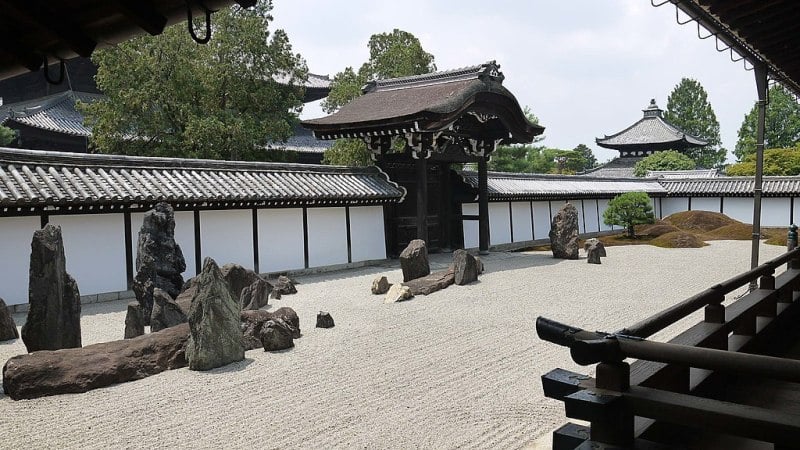
The Tofuku-ji Temple, 800 years old, stands as one of Kyoto’s most remarkable landmarks with its four distinct Hojo Gardens. Statesman Kujo Michiie built this masterpiece by combining elements from two major Nara temples: Todai-ji and Kofuku-ji. This temple belongs to the prestigious ‘Kyoto Gozan’ group and still maintains its authentic medieval Zen architecture.
Garden designer Mirei Shigemori transformed the temple’s landscape in 1939 by creating four unique gardens around the Hojo (Abbot’s Quarters). The Japanese government recognized these gardens’ significance and designated them as places of scenic beauty in 2014.
The South Garden showcases classic Zen esthetics through four massive rock clusters. These rocks represent the mythical Horai isles from Chinese mythology, surrounded by white gravel raked with precision. Five moss-covered mounds stand at one end, symbolizing Rinzai Zen’s principal temples. Shigemori added a bold touch by separating moss and gravel with a straight diagonal concrete edge – a design choice traditionalists found controversial.
The North Garden displays Shigemori’s creativity through square paving stones. They form a checkerboard pattern in moss that seems to dissolve into randomness. Japanese maples beyond the garden create stunning autumn views through this gradual dispersion.
The West Garden showcases azalea shrubs in a distinctive checkerboard pattern that mirrors traditional rice fields. This design element became Shigemori’s signature style, drawing inspiration from Katsura Imperial Villa’s centuries-old ichimatsu checked pattern.
The East Garden stands out as the most unconventional space. Seven truncated stone cylinders, repurposed from the temple’s old outhouse foundation, create a representation of the Big Dipper constellation. This thoughtful arrangement symbolizes the purification ritual visitors perform before entering Buddhist temples.
These gardens show how modern esthetics can breathe new life into traditional Zen principles. They remain a great way to get insight into the most innovative Japanese gardens Kyoto has to offer while maintaining their spiritual essence.
8. Koke-dera (Saihoji)
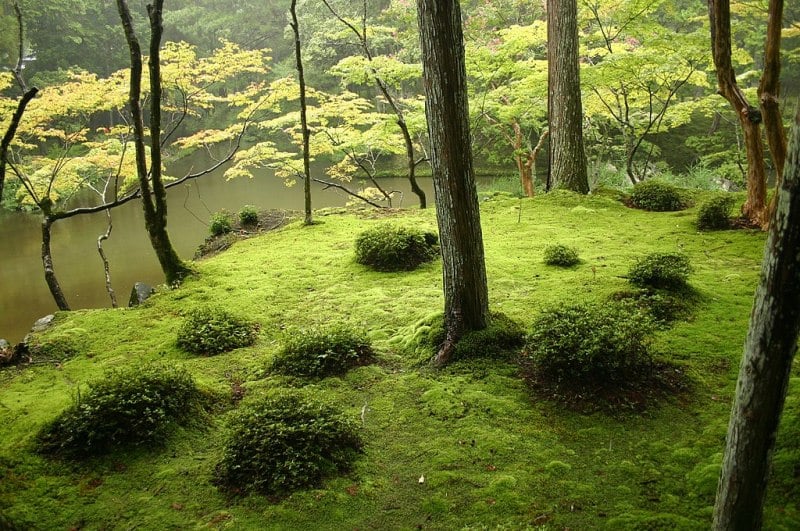
Saihoji, also known as “Koke-dera” or “Moss Temple,” showcases a stunning mixture of over 120 moss varieties throughout its magical grounds. The temple became a UNESCO World Heritage Site in 1994. Nature lovers rank this green sanctuary among the best gardens in Kyoto because it combines spiritual peace with natural beauty.
This remarkable temple started as Prince Shotoku’s villa during the Nara period before it became a Buddhist temple. The famous Zen monk Muso Soseki renovated the temple in 1339 and turned it into a Rinzai Zen Buddhist temple. The garden took more than a century to get its full moss coverage. Today, visitors can admire this breathtaking sight.
The garden circles around Golden Pond (Ōgonchi) in a thoughtful design. The pond’s shape mirrors the Chinese character for “heart” or “mind”. Three small islands sit in this heart-shaped pond: Asahi Island, Yūhi Island, and Kiri Island. The upper section features a traditional Zen dry landscape with rocks that look like waterfalls and mountains.
You need to plan ahead to visit this Japanese garden in Kyoto. The temple requires reservations, which you can make online or through return postcard with an international reply coupon. The entry costs 4,000 yen, making it the priciest among gardens of Kyoto. Visitors must join a Buddhist ceremony and copy sutras (shakyo) before they can see the garden.
The garden looks its best during two seasons. The East Asian rainy season from early June to mid-July makes the moss look extra lush. Late autumn brings colorful leaves that create beautiful contrasts against the green moss carpet.
The temple sits just two minutes from the Kokedera Suzumushidera bus stop. Take Kyoto Bus 73 or 83 to get there. This moss-covered paradise blends spiritual practice with natural beauty, making it a must-see for anyone exploring the best Japanese gardens in Kyoto.
9. Shisen-do Temple’s Garden
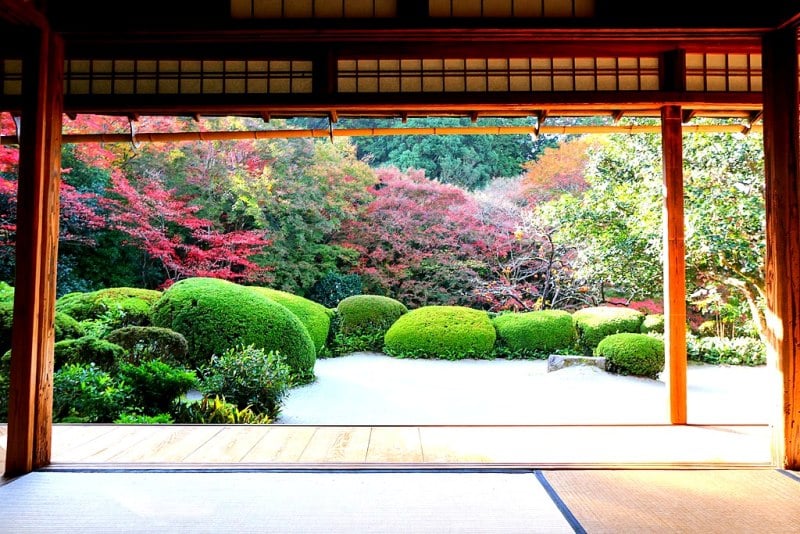
Shisen-do temple features one of the most peaceful gardens in Kyoto, hides behind a modest exterior and perfectly balances simplicity with deep cultural meaning. A former samurai named Ishikawa Jozan, who served Tokugawa Ieyasu, built this hermitage in 1641 as his quiet retreat after leaving military service.
The name “Hall of Immortal Poets” comes from an impressive collection of 36 Chinese poet portraits that hang in the main room. Famous artist Kanō Tan’yū painted these portraits. Visitors walk through a bamboo path and discover both dry garden and stroll garden features. The garden’s design focuses on karikomi (clipped shrubs).
The garden’s most remarkable features are satsuki azaleas trimmed into mountain shapes that blend with areas of white sand representing the sea. The design merges naturally with the nearby hillside, which adds depth to the overall view.
Shisen-do changes beautifully through the seasons. Bright pink azaleas fill the spring views, while maple trees create stunning orange displays in autumn.
The garden’s peaceful atmosphere comes alive with a unique bamboo water fixture (sōzu). This device makes a hollow “thunk” sound as water fills and empties it. This marked the first time anyone used such a device in garden design.
After Jozan died at 90 in 1672, Buddhist priests took care of the hermitage until Zen practitioners became its guardians. Today, Shisen-do operates as a temple and gives visitors a unique window into Japan’s rich cultural and esthetic traditions.
10. Okochi Sanso Garden
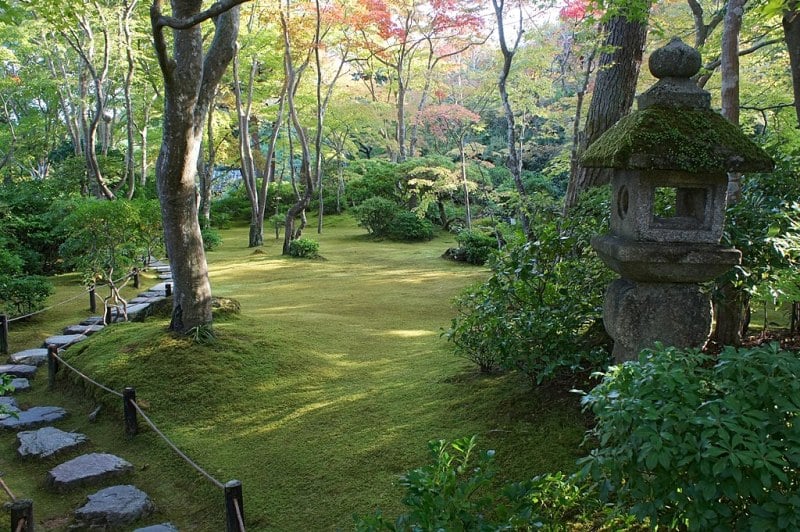
The best gardens in Kyoto hides a cinematic gem right next to Arashiyama’s famous bamboo forest. Japanese silent film actor Denjiro Okochi (1898-1962) spent three decades creating his perfect retreat here, which became the Okochi Sanso Garden.
This garden stretches across 20,000 square meters. Visitors can explore winding pathways and cobblestone steps that showcase seasonal beauty throughout the year. The garden’s unique position on Mount Ogura’s slopes gives visitors stunning views of Kyoto city below.
The grounds have several architectural treasures scattered throughout the multi-level landscape. A traditional Japanese house stands alongside various teahouses and Shinto shrines. These structures, built during the 1930s and 1940s, remain remarkably well-preserved today.
The garden tour ends at the main teahouse where your ¥1,000 admission ticket comes with traditional matcha tea and a Japanese sweet. You can choose seats that look out over either the Japanese house and garden or the beautiful bamboo groves below.
This garden serves as a peaceful alternative to Arashiyama’s busy tourist spots. Many visitors prefer Okochi Sanso to the Imperial Palace because they can explore freely without tour guides. The late afternoon light creates stunning photo opportunities as it filters through the foliage.
Conclusion
My trip through Kyoto’s magnificent gardens has taught me so much about Japan’s artistic, cultural, and spiritual development. Each garden shares its own unique story – you’ll find 120 varieties of moss at Koke-dera and mysterious rock arrangements at Ryoanji. These green sanctuaries are nowhere near just beautiful spaces. They open windows into centuries of Japanese philosophy and design principles.
Kyoto’s gardens stand out because of their amazing diversity. The city naturally combines formal Zen rock gardens, sprawling botanical collections, imperial stroll gardens, and intimate temple retreats. Cherry blossoms paint these spaces pink in spring. Autumn brings dramatic maple displays that create stunning contrasts against the well-maintained moss and gravel.
These gardens are living museums that deserve recognition. They stay meticulously preserved yet change with the seasons. The Kyoto Botanical Gardens shows nature’s variety with its 12,000 plant species. Byodo-in takes you to a Buddhist paradise through its symbolic design. The Katsura Imperial Villa shows Japanese architecture’s perfect harmony with nature.
Most visitors rush through Kyoto’s famous temples without taking time to appreciate their gardens. Here’s my advice: give yourself plenty of time at each spot. Take a quiet moment on a bench at Shisen-do. Listen to the bamboo water fixture or find a peaceful corner at Kyoto Gyoen to take in the beauty around you.
These ten gardens are perfect for everyone – garden lovers, photographers, history enthusiasts, or anyone looking for peace away from Japan’s busy tourist spots. They offer unmatched experiences that show the heart of Japanese esthetic principles. Kyoto’s gardens remain among Japan’s greatest cultural treasures. They’re living artworks that keep inspiring visitors from across the globe.
FAQs
Q1. What is considered the most famous garden in Kyoto? Ryoanji Temple’s Rock Garden is widely regarded as Kyoto’s most famous garden. Its minimalist design of carefully arranged rocks on a bed of raked gravel has become iconic of Japanese Zen gardens worldwide.
Q2. Are there any specific rules to follow when visiting Japanese gardens? Yes, there are several etiquette guidelines for garden visits. These include staying on designated paths, refraining from picking plants or feeding animals, not bringing food or drinks (except water), and maintaining a quiet, respectful demeanor.
Q3. How much time should I allocate for visiting the Kyoto Botanical Gardens? A typical visit to the Kyoto Botanical Gardens takes about 2-3 hours. This allows enough time to explore the various themed areas and appreciate the diverse plant collections without feeling rushed.
Q4. What makes Japanese gardens unique? Japanese gardens are distinctive for their careful balance of natural and man-made elements. They often incorporate symbolic features like rock arrangements, water features, and carefully pruned plants to create miniature landscapes that evoke larger natural scenes.
Q5. Which season is best for visiting Kyoto’s gardens? Each season offers a unique experience in Kyoto’s gardens. Spring is popular for cherry blossoms, summer showcases lush greenery, autumn brings vibrant foliage colors, and winter offers serene snow-covered landscapes. The best time depends on your preferences and the specific gardens you wish to visit.
